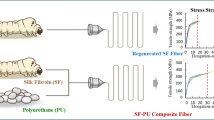Abstract
Silk fibroin (SF) is a promising material for biomedical applications especially in the form of nanogels that combine the advantages of nanotechnology and cross-linking gel-like systems with various superior properties in biological environment. The present study describes the preparation of a semi-interpenetrating (semi-IPN) network using SF and polyacrylamide (PAAm) in the presence of N,N′-methylenebis(acrylamide) (BAAm) as a chemical crosslinker. While the particles were obtained by an inverse microemulsion method, photo-polymerization reactions were performed with Irgacure as an initiator. UV irradiation time and SF concentrations were adjusted to get stable Semi-IPN nanogels with a size smaller than 200 nm. Fourier transform infrared spectroscopy (FT-IR), dynamic light scattering (DLS), transmission electron microscopy (TEM) and X-ray diffraction (XRD) analyses were used for sample characterizations. FT-IR measurements proved both the existence of SF and PAAM in the nanogel structure and also β-sheet formation of SF with methanol treatment. A characteristic peak at 20.0 A° corresponding to the β-sheet crystalline structure of SF was obtained by XRD analysis. In addition to the dialysis purification, smaller particles can be obtained with a size around 100 nm by increasing SF concentration. DLS results were supported by TEM images of nanogels with a spherical shape. The results indicated that optimized conditions are suitable for the development of SF nanogels with potential applications in drug delivery.








Similar content being viewed by others
References
Altman GH, Horan RL, Lu HH, Moreau J, Martin I, Richmond JC, Kaplan DL (2002) Silk matrix for tissue engineered anterior cruciate ligaments. Biomaterials 23:4131–4141. https://doi.org/10.1016/s0142-9612(02)00156-4
Antonietti M, Landfester K (2002) Polyreactions in miniemulsions. Prog Polym Sci 27:689–757. https://doi.org/10.1016/S0079-6700(01)00051-X
Asakura T, Kuzuhara A, Tabeta R, Saito H (1985) Conformational characterization of Bombyx mori silk fibroin in the solid state by high-frequency carbon-13 cross polarization-magic angle spinning NMR, X-ray diffraction, and infrared spectroscopy. Macromolecules 18:1841–1845. https://doi.org/10.1021/ma00152a009
Cappello J et al (1998) In-situ self-assembling protein polymer gel systems for administration, delivery, and release of drugs. J Controlled Release 53:105–117. https://doi.org/10.1016/s0168-3659(97)00243-5
Candau F (1997) Inverse emulsion and microemulsion polymerization. In: Lovell PE-AM (ed) Emulsion polymerization and emulsion polymers. Wiley, West Sussex, p 723
Freddi G, Tsukada M, Beretta S (1999) Structure and physical properties of silk fibroin/polyacrylamide blend films. J Appl Polym Sci 71:1563–1571. https://doi.org/10.1002/(sici)1097-4628(19990307)71:10<1563:Aid-app4>3.0.Co;2-e
Kaplan D, Adams WW, Farmer B, Viney C (eds) (1993) Silk: biology, structure, properties, and genetics. In: Silk polymers. ACS symposium series, vol 544. American Chemical Society, pp 2–16. https://doi.org/10.1021/bk-1994-0544.ch001
Kim U-J, Park J, Li C, Jin H-J, Valluzzi R, Kaplan DL (2004) Structure and properties of silk hydrogels. Biomacromol 5:786–792. https://doi.org/10.1021/bm0345460
Leisk GG, Lo TJ, Yucel T, Lu Q, Kaplan DL (2010) Electrogelation for protein adhesives. Adv Mater (Deerfield Beach, Fla) 22:711–715. https://doi.org/10.1002/adma.200902643
Megeed Z, Cappello J, Ghandehari H (2002) Genetically engineered silk-elastinlike protein polymers for controlled drug delivery. Adv Drug Deliv Rev 54:1075–1091. https://doi.org/10.1016/s0169-409x(02)00063-7
Melke J, Midha S, Ghosh S, Ito K, Hofmann S (2016) Silk fibroin as biomaterial for bone tissue engineering. Acta Biomater 31:1–16. https://doi.org/10.1016/j.actbio.2015.09.005
Mo C, Holland C, Porter D, Shao Z, Vollrath F (2009) Concentration state dependence of the rheological and structural properties of reconstituted silk. Biomacromol 10:2724–2728. https://doi.org/10.1021/bm900452u
Myung SJ, Kim H-S, Kim Y, Chen P, Jin H-JJMR (2008) Fluorescent silk fibroin nanoparticles prepared using a reverse microemulsion. Macromol Res 16:604–608. https://doi.org/10.1007/bf03218567
Nayak S, Lyon LA (2005) Soft nanotechnology with soft nanoparticles. Angew Chem (Int Ed Engl) 44:7686–7708. https://doi.org/10.1002/anie.200501321
Rnjak-Kovacina J, Wray LS, Burke KA, Torregrosa T, Golinski JM, Huang W, Kaplan DL (2015) Lyophilized silk sponges: a versatile biomaterial platform for soft tissue engineering. ACS Biomater Sci Eng 1:260–270. https://doi.org/10.1021/ab500149p
Seib FP (2018) Reverse-engineered silk hydrogels for cell and drug delivery. Ther Deliv 9:469–487. https://doi.org/10.4155/tde-2018-0016
Tanaka K et al (1999) Determination of the site of disulfide linkage between heavy and light chains of silk fibroin produced by Bombyx mori. Biochem Biophys Acta 1432:92–103. https://doi.org/10.1016/s0167-4838(99)00088-6
Wang X, Yucel T, Lu Q, Hu X, Kaplan DL (2010) Silk nanospheres and microspheres from silk/pva blend films for drug delivery. Biomaterials 31:1025–1035. https://doi.org/10.1016/j.biomaterials.2009.11.002
Xiao W et al (2011) Synthesis and characterization of photocrosslinkable gelatin and silk fibroin interpenetrating polymer network hydrogels. Acta Biomater 7:2384–2393. https://doi.org/10.1016/j.actbio.2011.01.016
Yucel T, Cebe P, Kaplan DL (2009) Vortex-induced injectable silk fibroin hydrogels. Biophys J 97:2044–2050. https://doi.org/10.1016/j.bpj.2009.07.028
Zhang Y-Q, Shen W-D, Xiang R-L, Zhuge L-J, Gao W-J, Wang W-B (2007) Formation of silk fibroin nanoparticles in water-miscible organic solvent and their characterization. J Nanopart Res 9:885–900. https://doi.org/10.1007/s11051-006-9162-x
Zhao Z, Li Y, Xie M-B (2015) Silk fibroin-based nanoparticles for drug delivery. Int J Mol Sci 16:4880–4903. https://doi.org/10.3390/ijms16034880
Acknowledgements
This study was financially supported by the Scientific Research Projects Committee of Bezmialem Vakif University (BAP, 9.2017/24), Istanbul, Turkey.
Author information
Authors and Affiliations
Corresponding author
Ethics declarations
Conflict of interest
The authors declare that they have no conflict of interest.
Additional information
Publisher's Note
Springer Nature remains neutral with regard to jurisdictional claims in published maps and institutional affiliations.
Electronic supplementary material
Rights and permissions
About this article
Cite this article
Tuncel, M., Ceylan Tuncaboylu, D. Preparation of semi-interpenetrating silk fibroin–polyacrylamide nanogels. Polym. Bull. 78, 3043–3054 (2021). https://doi.org/10.1007/s00289-020-03245-w
Received:
Revised:
Accepted:
Published:
Issue Date:
DOI: https://doi.org/10.1007/s00289-020-03245-w





